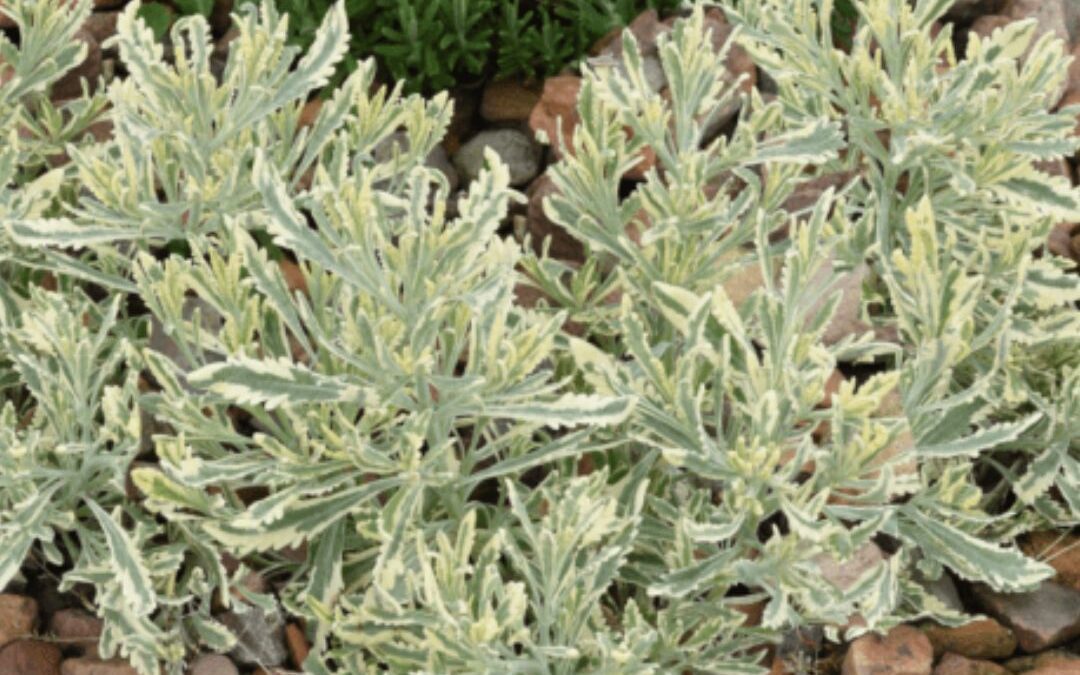I love Meerlo lavender (Lavender allardii ‘Meerlo’). It’s so different from every other lavender, while still maintaining its aroma and lavender look.
What makes it different from other lavenders, you ask? The beautiful and unique way it mixes in with the landscape! The mellow and creamy yellow variegation adds a brightness you don’t usually get from lavender.
That uniqueness is one of the reasons I love to use it, but there are many more. So without further ado, let’s dig in to the top five reasons to plant Meerlo lavender now.
1. Meerlo lavender brightens a garden with its year-round color.
While a typical lavender runs between green and grey, Meerlo lavender provides yearlong interest to the garden with a bright cream to mellow yellow in the side margins of the grey-green leaves.
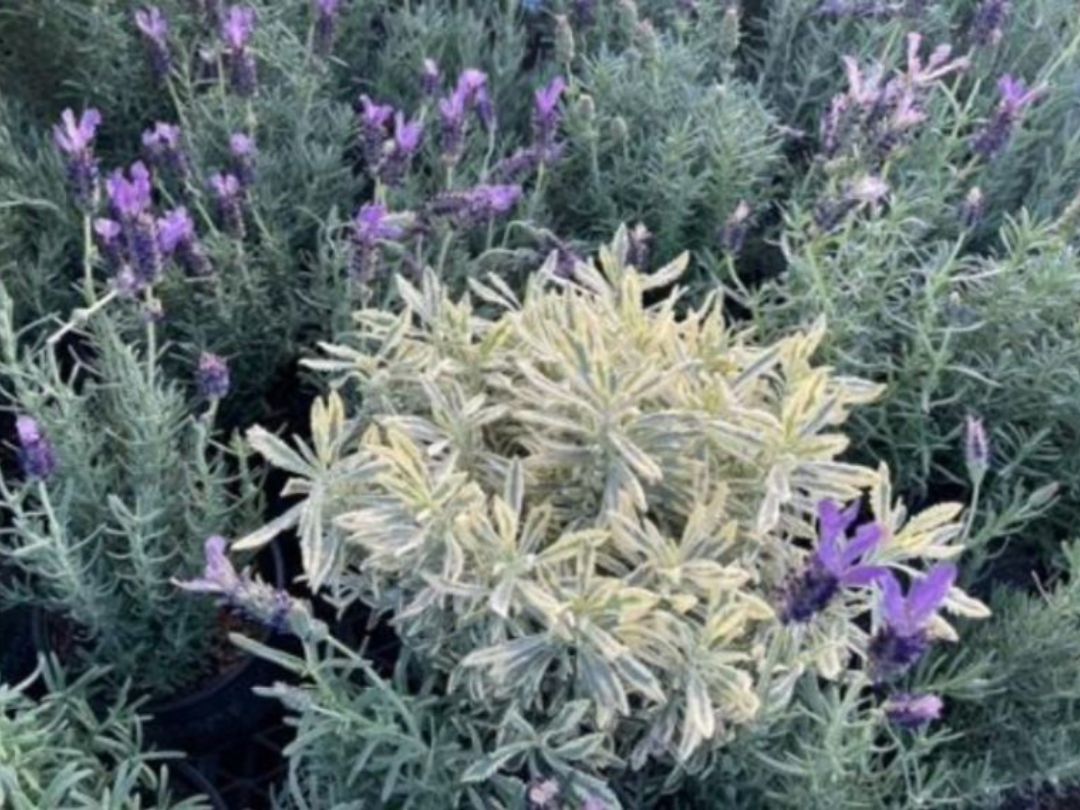
The image above is Meerlo lavender with a Spanish Lavender (Lavandula stoechas ‘Laveanna Grand Purple’).
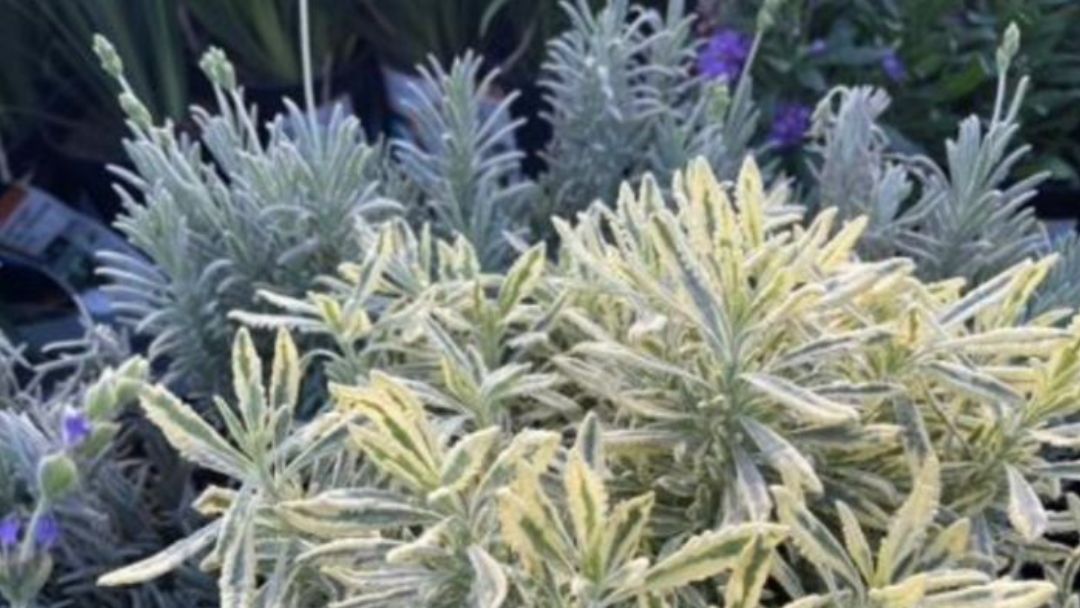
The image above is Meerlo lavender with Goodwin Creek, a French lavender (Lavandula ‘Goodwin Creek Grey’).
2. Meerlo lavender plays great with others.
This lavender combines beautifully with so many other plants. There are so many great Meerlo Lavender plant combinations.
Some like the drama of a deep red or burgundy with Meerlo lavender.
The Sunset Plant collection would have you pairing it with the likes of Black Adder phormium and Leucandendron Ebony. Both of these plants have dramatic burgundy foliage, a clash of colors that is dramatic and beautiful when paired with Meerlo lavender.

This image above is Meerlo lavender with thin leaves of Red Fountain grass (Pennisetum x advena Rubrum’) in front and to the left of the lavender, and the thicker leaves of Cordyline ‘Red Sensation’ (Crodyline australis ‘Red Sensation’) behind and to the right.
I prefer to bring out the calmer beauty of the plant. Meerlo lavender would look beautiful boxed in by the crisp and dark greens of boxwoods . . .
Or in a mix with grey-green lavenders (see the first two photos of this post), or in a sea of ground cover rosemary with dwarf lemons hanging from a tree above.
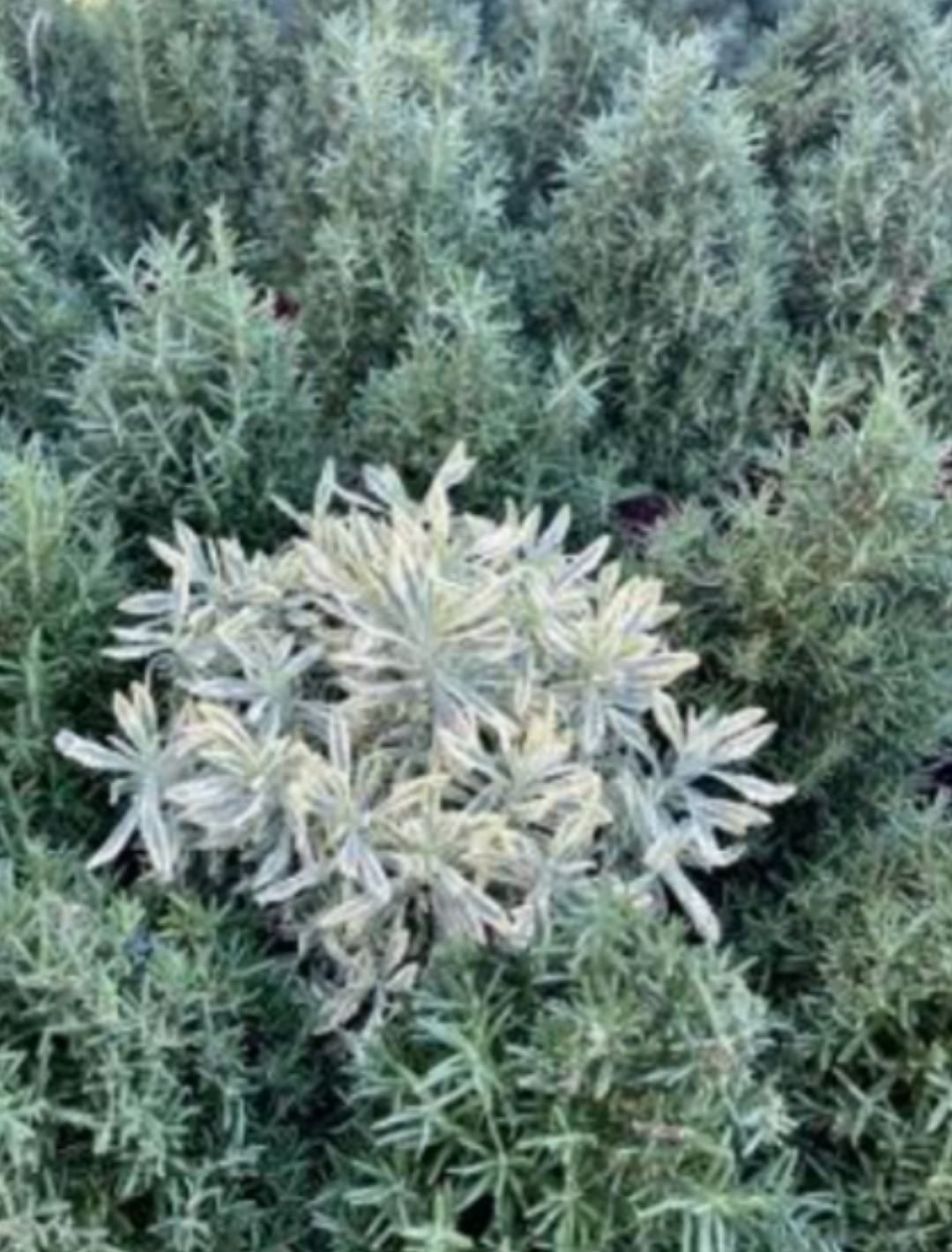
The image above is Meerlo lavender in a sea of rosemary.
Great companion plants for Meerlo Lavender include artemisia. The lacy leaves of the artemisia create a lovely background to help Meerlo lavender really shine.
The Sunset Western Garden Collection has an image of Meerlo lavender with the blue-grey of festuca, which brings out the more subtle greys in the grey-green in the center of the serrated leaves of Meerlo lavender.
This grey-green can also be echoed with an Echeveria like Mexican Hens and Chicks or Blue Chalksticks.
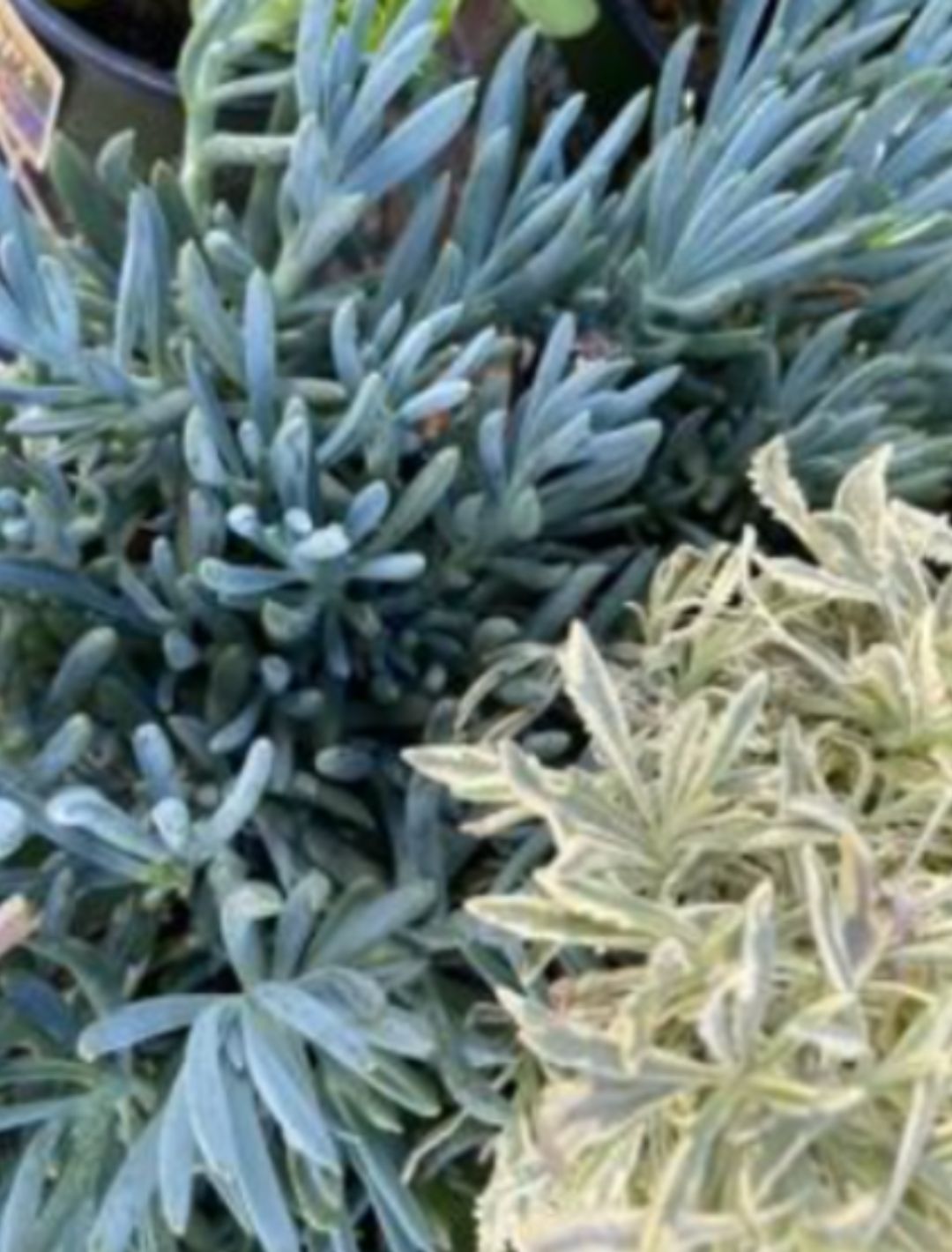
This image is of Meerlo Lavender with powdery-blue leaves of Blue Chalksticks (Senecio repens).
3. Meerlo lavender is drought tolerant and can take the heat.
How important is that! The low water needs of this plant will save you on the water bill. We are talking seriously DROUGHT TOLERANT. This plant is one of the most drought and heat tolerant lavenders on the market.

Besides being a tough lavender, another great quality is that the Meerlo looks so lush.
Which means you don’t have to settle for a dry looking landscape when you want to go drought tolerant.
Not only is this lavender water-wise, it’s a hardy and easy-to-care-for plant. The general rule is to cut back the plant by about 1/3 after it flowers to keep the lavender compact.
This plant likes little to no fertilizer.
4. Meerlo lavender has the ability to handle sun—and some shade.
All the lavenders I can think of need full sun, wanting at least 6-8 hours a day of sunlight. Except for Meerlo lavender!
Its ability to handle different sun levels makes it very versatile in the garden. Because it is such a showy plant, adding a few in different areas will help create cohesion in your garden.
This lovely plant also has a fast growth rate, mounding to a 2-3’ form, filling in those sunny or partially sunny spots quicker.
5. Another reason to plant Meerlo lavender? It’s a LAVENDER!
And who doesn’t love lavender?
Meerlo lavender ( Lavandula x allardii) is a cross between French Lavender, Lavandula dentata and Spike Lavender, Lavandula latifoila.
Meerlo lavender has the small bracts and slightly serrated leaves of the French Lavender and tall slender stems of Spike Lavender. Both French and Spike Lavender are used for their essential oils.
There’s little I like more than a plant that is beautiful AND useful!
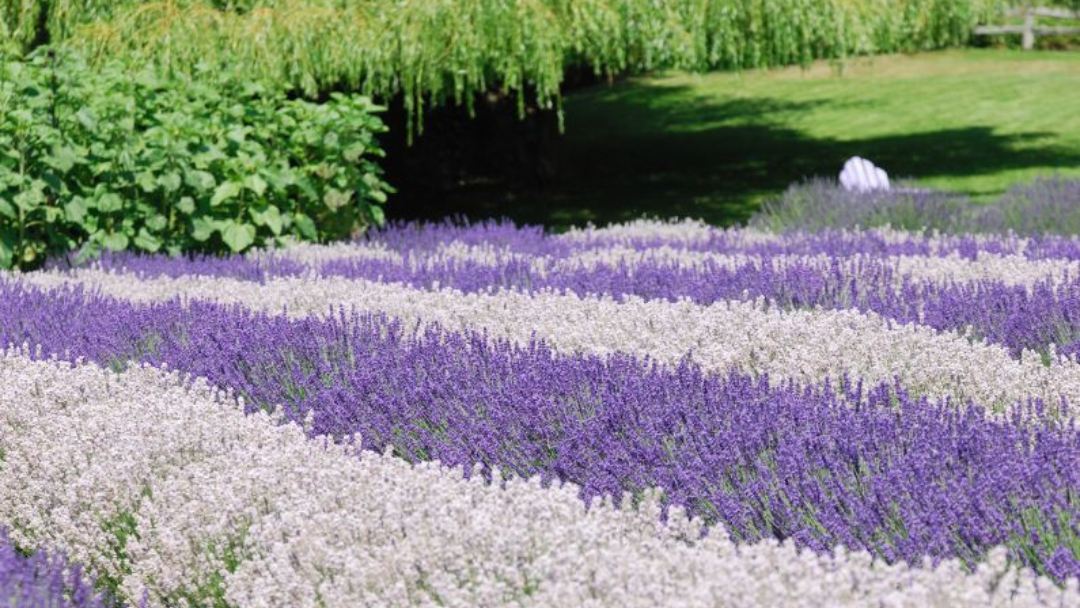
The slightly serrated leaves of Meerlo lavender are heavily scented, like their parent plants, and used for potpourri. The smell can permeate the garden just by rubbing the leaves together.
You can also dry the leaves for sachets and moth repellent.
In addition to the highly fragrant foliage, Meerlo lavender has pale blue flowers in mid to late summer, which are sweetly scented.
Unfortunately, the flowering period is rather short and not known to be highly prolific. But that’s only a slight drawback in this otherwise spectacular plant.
The flowers of this lavender are attractive to birds and bees. The flowers of Meerlo lavender are on 14-18” erect stems that are scented and great for bouquets.
If you’re cutting the lavender flower to dry, make sure to harvest the flowers when the buds are just about to flower. You’ll want to dry them on a dark space to help them retain their color. Hang them upside down to help the flowers maintain their shape. It usually only takes about a week for the moisture in the plant to dry.
Haven’t heard of Meerlo lavender before? Here’s why.
Meerlo lavender is a relatively new plant.
What I have found from internet searches (thank you San Marcos Growers!) is that this plant mutation of Lavender allardi was discovered in 2011 by Louis Meerlo of Classic Plants in New Zealand.
The first Lavendula x allardi ‘Meerlo’ to be sold was in 2015!!!
When you think about the history of lavender, that’s fascinating. Lavender has been around since ancient Greek and Roman times, but this particular plant is only in the double digits!
Need to get this plant now?
There are so many options for buying this plant! You can try Home Depot, where you’ll find the plant by the common name ‘Mint Julep’. Or go into Lowes. Or Walmart (which also provides a handy information sheet on the plant. There is also online availability on Etsy. The owner of The Garden Bee sells this lovely lavender and you can find that seller here. But, first try your local nursery.
More on lavender!
While I do use Meerlo lavender a lot, I also use the more traditional lavenders like ‘Provence’ lavender (Lavandula x intermedia ‘Provence’).
There are so many considerations when picking a lavender for your garden.
You can choose one that you like the looks of, the one that gets to the right size – or the one that provides you with beautiful cut flowers, aromatic leaves, or buds for a good cup of tea!
It is important to remember that dried lavender is much stronger than fresh lavender.
For cooking, English lavender (Lavandula angustifolia) is often used. This type of lavender has a lot less oil and is sweeter and more palatable.
Examples of English lavender are ‘Munstead’ (Lavandula angustifolia ‘Munstead) and ‘Hidcote’ (Lavandula angustifolia ‘Hidcote’).
‘Provence’ is also used in the kitchen.
If you want to give culinary lavender a try, try making lavender sugar by mixing some lavender buds in granulated sugar and allowing it to sit for a week or two, shaking the jar daily. Grind this mix to use when you make cookies and cakes.
When you think of using lavender in the kitchen, it can be helpful to remember that it’s in the mint family. It’s edible, but some taste better than others.
The lavender plants with more camphor taste more bitter—more like medicine or soap. Spike Lavender is intensely camphoric, so I don’t think you’ll be seeing Meerlo lavender on any menus!

